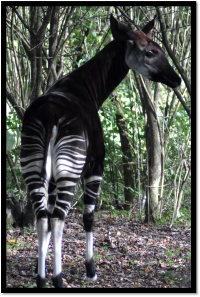This is an old revision of the document!
OKAPI
Class: MAMMALIA
Order: ARTIODACTYLA
Family: GIRAFFIDAE
Genus: OKAPIA
Species: JOHNSTONI
The closest living relative to the giraffe. The Okapi, a denizen of dense rainforest, is found in a restricted range of the Democratic Republic of Congo, formerly Zaire. The okapi and giraffe diverged some 11 million years ago, with the other giraffoids now extinct. It is thought that other giraffoids would have resembled the okapi, being short-necked, perhaps with similar patterning. They perhaps also had a similar niche, feeding on shrubs such as bushes.
I. OKAPI DISCOVERY
Whilst the Western world had not heard of the Okapi until 1902, it would be inaccurate to say that no human had ever saw one - the pygmies living in the Congo surely had encountered Okapi for thousands of years, and trapped, skinned, and ate them. In fact, the modern name of the okapi is derived from the word that pygmies used to describe the animal, sounding similar to 'okwapi'. Occasionally, explorers of Europe would encounter the Okapi, but the animals, being timid, quickly ran back into the underbrush. The okapi, hence, was heard only in Europe from the mouths of European explorers, who described an animal like a donkey, with stripes on its rear end. It would be the works of Harry Johnston that would lead to the Okapi's discovery to Western science.
In his youth, Johnston had heard of the animal known to mythology as the 'unicorn'. And upon hearing that this mysterious animal of the Congo had horns, Johnston started to wonder if he would be seeing a unicorn of his own. What Johnston found curious was that his mystery animal was sometimes described as a horse or donkey. However, horses and donkeys were animals of open plains as so to run easily, not dense jungle. But the pygmies were the only people who knew anything about this animal, so that is where he would turn to.
The pygmies told him the animal had more than one hoof, so it could not be any kind of horse or donkey. Then, Johnston thought perhaps this could be the ancient Hipparion, a primitive horse-ancestor. It was later found that the mysterious animal in fact had two toes. Soon, however, Johnston, and the pygmies, would become sick with malaria, bringing a halt to discovering the mystery animal. All that Johnston had to show for it was two pieces of hide from the animal's rear end. However, Johnston ambitioned to soon have a perfect hide. For now, he would dub his mystery animal “Equus (?) Johnstoni”.
What Johnston found curious was that his mystery animal was sometimes described as a horse or donkey. However, horses and donkeys were animals of open plains as so to run easily, not dense jungle. But the pygmies were the only people who knew anything about this animal, so that is where he would turn to.
The pygmies told him the animal had more than one hoof, so it could not be any kind of horse or donkey. Then, Johnston thought perhaps this could be the ancient Hipparion, a primitive horse-ancestor. It was later found that the mysterious animal in fact had two toes. Soon, however, Johnston, and the pygmies, would become sick with malaria, bringing a halt to discovering the mystery animal. All that Johnston had to show for it was two pieces of hide from the animal's rear end. However, Johnston ambitioned to soon have a perfect hide. For now, he would dub his mystery animal “Equus (?) Johnstoni”.

